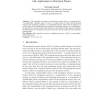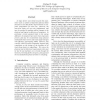3820 search results - page 3 / 764 » Computational Physics |
CE
2004
13 years 5 months ago
2004
Much computer-based learning is largely passive, based primarily on task-based, exercise-driven interactions. We argue that computers have greater potential for promoting more act...
JUCS
2008
13 years 5 months ago
2008
: The topological pressure of dynamical systems theory is examined from a computability theoretic point of view. It is shown that for sofic shift dynamical systems, the topological...
ISWC
2002
IEEE
13 years 10 months ago
2002
IEEE
The representation of physical space has traditionally focused on keyphrases such as “Computer Science Building” or “Physics Department” that help us in describing and nav...
ISMVL
2005
IEEE
13 years 11 months ago
2005
IEEE
As logic device sizes shrink towards the nanometer scale, a number of important physical limits threaten to soon halt further improvements in computer performance per unit cost. H...
BIOSYSTEMS
2007
13 years 5 months ago
2007
The computational process is based on the activity linking mathematical equations to a materialized physical world. It consumes energy which lower limit is defined by the set of ...


